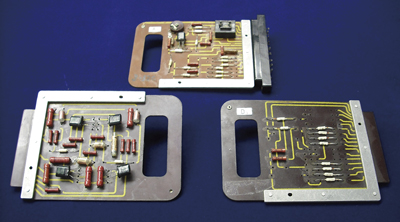

- Home >
- Artifacts of IP Heritage >
- 2014 >
- HITAC 301 Components
HITAC 301 Components

| Manufactured in | 1957 |
|---|---|
| Manufactured by | Hitachi, Ltd. |
| Owner | Hitachi, Ltd. |
| Location of historical materials | Hitachi, Ltd. 292, Yoshidacho, Totsuka-ku, Yokohama-shi, Kanagawa-ken, 244-0817 Japan |
| Visitor information | Not open to the public (Ask for a visit) |
| Contact | https://www.hitachi.co.jp/products/it/portal/museum/ |
The HITAC 301 was Hitachi's first transistor computer. Development began around May 1958, with technical assistance from the Electro Technical Laboratory, which had completed the ETL Mark IV. The HITAC 301 used the basic circuitry of the ETL Mark IV almost unchanged and was heavily influenced by the ETL Mark IV architecturally as well, using a magnetic drum unit and a base-10 serial-parallel computation method. Where the HIPAC MK-1 was designed for technical calculations, this machine was oriented toward business processing. With the ETL Mark IV as a model, Hitachi extended the computer's word length to a sign bit plus 12 bits and used a paired-order format to fit two instructions into one word. The HITAC 301 also featured such innovations as overflow detection and partial simultaneous input/output operations. The magnetic drum unit was designed to be the best available at the time, with a speed of 12,000 RPM and a capacity of 1,960 words.
To distinguish it from the HIPAC which used parametrons, this machine was called the HITAC (Hitachi Transistor Automatic Computer) 301. It was completed in April 1959 and delivered to the Japan Electronic Industry Development Association in May of that year. This was the first machine under the HITAC brand, which continues to this day.
No complete HITAC 301 machine exists today, but components of the machine — a clock-pulse generator circuit, a logic gate circuit, and a basic logic circuit — do remain.
